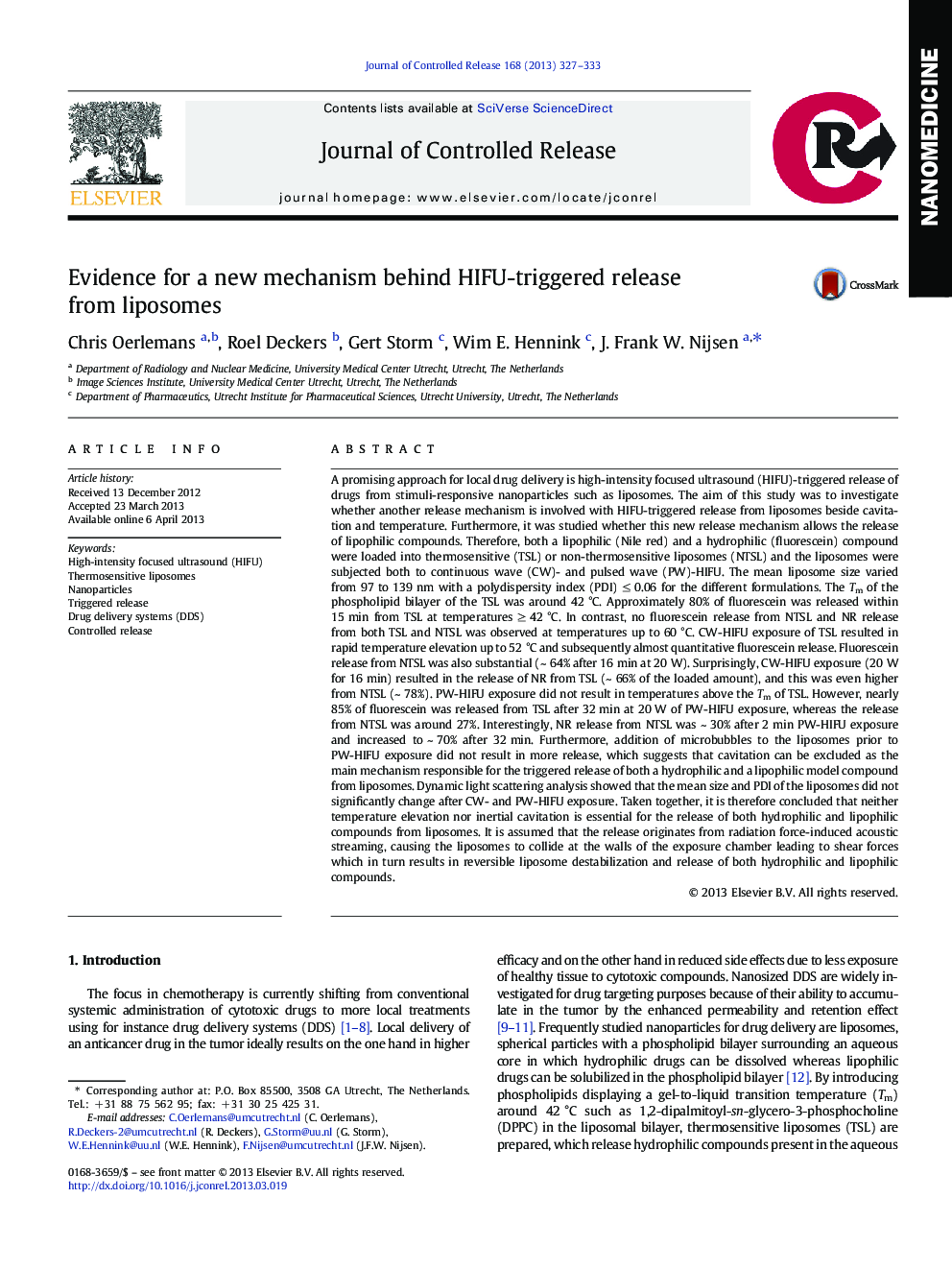| کد مقاله | کد نشریه | سال انتشار | مقاله انگلیسی | نسخه تمام متن |
|---|---|---|---|---|
| 1424211 | 986705 | 2013 | 7 صفحه PDF | دانلود رایگان |

A promising approach for local drug delivery is high-intensity focused ultrasound (HIFU)-triggered release of drugs from stimuli-responsive nanoparticles such as liposomes. The aim of this study was to investigate whether another release mechanism is involved with HIFU-triggered release from liposomes beside cavitation and temperature. Furthermore, it was studied whether this new release mechanism allows the release of lipophilic compounds. Therefore, both a lipophilic (Nile red) and a hydrophilic (fluorescein) compound were loaded into thermosensitive (TSL) or non-thermosensitive liposomes (NTSL) and the liposomes were subjected both to continuous wave (CW)- and pulsed wave (PW)-HIFU. The mean liposome size varied from 97 to 139 nm with a polydispersity index (PDI) ≤ 0.06 for the different formulations. The Tm of the phospholipid bilayer of the TSL was around 42 °C. Approximately 80% of fluorescein was released within 15 min from TSL at temperatures ≥ 42 °C. In contrast, no fluorescein release from NTSL and NR release from both TSL and NTSL was observed at temperatures up to 60 °C. CW-HIFU exposure of TSL resulted in rapid temperature elevation up to 52 °C and subsequently almost quantitative fluorescein release. Fluorescein release from NTSL was also substantial (~ 64% after 16 min at 20 W). Surprisingly, CW-HIFU exposure (20 W for 16 min) resulted in the release of NR from TSL (~ 66% of the loaded amount), and this was even higher from NTSL (~ 78%). PW-HIFU exposure did not result in temperatures above the Tm of TSL. However, nearly 85% of fluorescein was released from TSL after 32 min at 20 W of PW-HIFU exposure, whereas the release from NTSL was around 27%. Interestingly, NR release from NTSL was ~ 30% after 2 min PW-HIFU exposure and increased to ~ 70% after 32 min. Furthermore, addition of microbubbles to the liposomes prior to PW-HIFU exposure did not result in more release, which suggests that cavitation can be excluded as the main mechanism responsible for the triggered release of both a hydrophilic and a lipophilic model compound from liposomes. Dynamic light scattering analysis showed that the mean size and PDI of the liposomes did not significantly change after CW- and PW-HIFU exposure. Taken together, it is therefore concluded that neither temperature elevation nor inertial cavitation is essential for the release of both hydrophilic and lipophilic compounds from liposomes. It is assumed that the release originates from radiation force-induced acoustic streaming, causing the liposomes to collide at the walls of the exposure chamber leading to shear forces which in turn results in reversible liposome destabilization and release of both hydrophilic and lipophilic compounds.
Figure optionsDownload high-quality image (146 K)Download as PowerPoint slide
Journal: Journal of Controlled Release - Volume 168, Issue 3, 28 June 2013, Pages 327–333